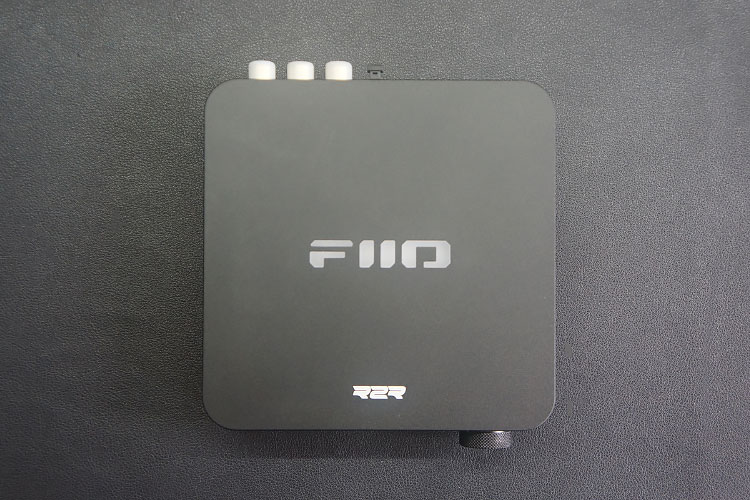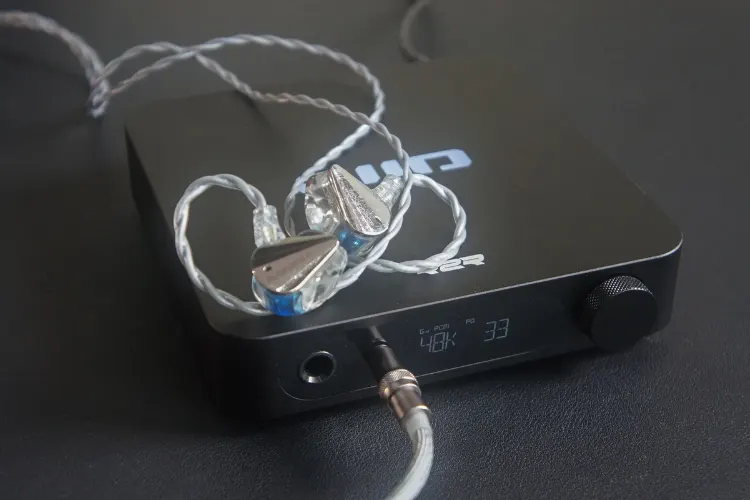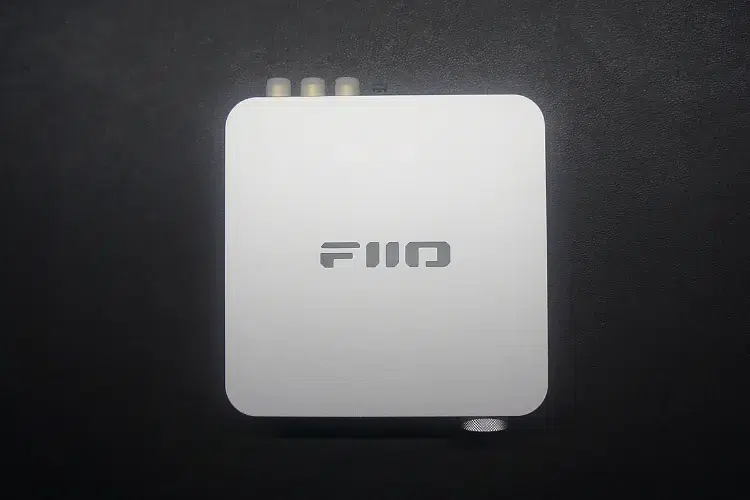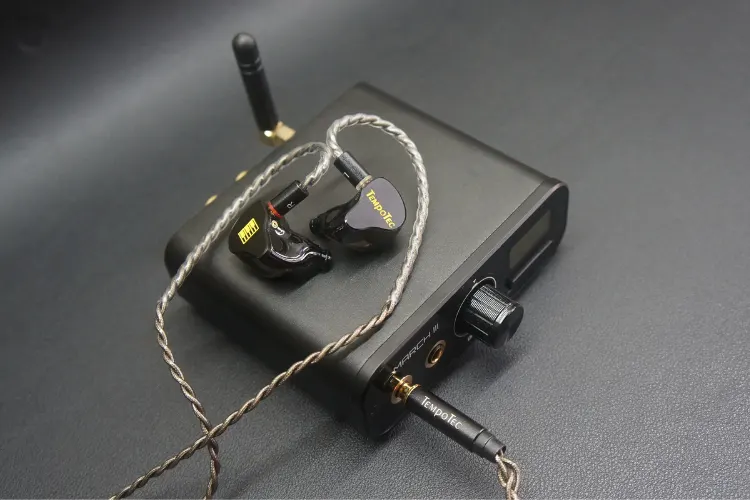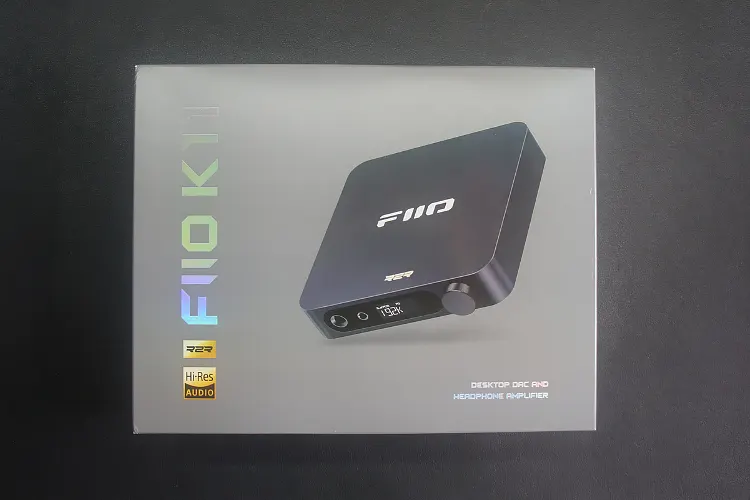Synergy
Power & Efficiency
The K11 R2R is a powerful and efficient DAC and headphone amplifier that can drive most headphones and earphones with ease.
The K11 R2R has an output power of up to 1300mW per channel at 32Ω on the balanced output, and up to 460mW per channel at 32Ω on the single-ended output.
Do not get me mistaken, this is still an impressive level of power from DAC/AMP of this size and form factor. However, its predecessor, the original K11, was able to deliver even more power at an even lower price point.
When connected to the K11 R2R’s balanced output, it was able to drive the Sennheiser HD 580 Precision to a more than satisfactory level at a high gain at around 38% volume.
The K11 can handle high-impedance and hard-to-drive headphones without any distortion or clipping. The K11 has a low noise floor and a high signal-to-noise ratio, which makes it suitable for quiet and critical listening.
At the medium gain setting, the K11 was able to easily drive IEMs such as the Moondrop Blessing 3 and 7Hz Aurora without any audible hiss.
Pairings
The K11 R2R shines when paired with headphones and IEMs that complement a warmer timber, whilst also maximizing the power the K11 R2R could offer. Throughout my testing, I found that the K11 R2R paired best with my HD 580 Precision.
This did not come as a surprise, since I already preferred pairing the HD 580 Precision with my hybrid tube amplifier, but K11 R2R surprised me with its ability to deliver a similar sense of warmth while preserving decent enough technicalities on its OS setting.
Through the Moondrop Blessing 3, I found the K11 R2Rs presentation of the mid-range to be too lean, detracting from the neutral Blessing 3 sound signature that I already enjoyed.
The 7Hz Aurora experienced a mid-bass boost when I paired it with the K11 R2R, but this muddied up the mid-range too much for my liking. For both IEMs, I preferred pairing them with the original K11 over the R2R version.
The Modhouse Argon’s already dark sound signature was muddied up by the additional warmth of the K11 R2R. Wherein I once again preferred its pairing with the original K11.
However moving forward, the K11 R2R will be my default source for the HD 580 Precision due to its balance of warmth and technical prowess.
Select Comparisons
All comparisons were performed with the FiiO K11 R2R on its OS sampling setting.
FiiO K11
Technical
The main difference between the two K11 iterations is the DAC configuration, with the original K11 opting for a Cirrus Logic CS43198 DAC chip, while the R2R variant uses a fully differential 24-bit R2R array DAC.
Both are equipped with dual SGM 8262 amplifiers, however, the R2R has a lower power output of 460mW and 1300mW @32Ω on 3.5mm SE and balanced 4.4mm respectively, compared to the original K11’s 520mW and 1400mW @32Ω.
These two share almost identical features with 6.3mm SE outputs and 4.4mm Balanced outputs in front, and RCA and Coaxial outputs in the rear.
Both units also come with optical and coaxial inputs. The main feature difference between both units is the K11 R2R’s inclusion of a pre-out mode, letting the user control the volume of a pair of powered monitors or amplifiers with the control dial when connected to the RCA output.
Additionally, the K11’s tuning options lie in the different DAC filter options, while the K11 R2R’s tuning options lie in the different sampling modes.
Design
Both have an identical design, using a square aluminum shell with an anodized finish, similar to the style used by Apple in their Mac Mini line of computers. Each unit has curved and chamfered edges that give off a simple yet elevated feel.
They also occupy the same amount of desk space, with the K11 R2R weighing slightly more. The main visual identified between the original K11 and the K11 R2R lies in the stylized “R2R” logo on the top surface of the K11 R2R.
Performance
Even on its OS setting, the FiiO K11 R2R has a warmer sound signature that is more relaxing but has less mid-range dynamics and fidelity compared to the original K11.
The K11 R2R has a slightly stronger sub-bass compared to the original K11, however, its warmth is mostly heard in the mid-bass region.
Bass guitars and synths have a more atmospheric feel with more weight through the K11 R2R. Bass guitar lines in funk tracks are more textured and satisfying with the additional warmth supplied by the R2R variant of the K11.
The mid-range performance of the K11 R2R takes a massive hit compared to the original K11. String instruments have better dynamics, detail, and texture when processed by the original K11.
The R2R’s mid-range sounds thinner in comparison, with string instruments coming off as one-dimensional and muffled by the R2R’s warmth.
The treble of the K11 R2R is worse across the board, playing back cymbals and chimes with less detail and air. In more complex mixes, treble instruments tend to mesh together in a sibilant mess, while the original K11 does a good job isolating each instrument and playing them back with a good sense of detail and sparkle.
Through my HD 580 precision, the additional warmth of the K11 R2R greatly improved vocal emotion and cooled down the sibilance of some S and T tones. This gave the HD 580 the more relaxing sound signature that I was looking for.
I preferred the K11 R2R when powering the HD 580. However, I preferred the original K11 when driving my Moondrop Blessing 3, highlighting the importance of gear synergy when deciding between the two K11 models.
iFi Audio ZEN DAC V1
Technical
The K11 R2R uses an in-house fully differential 24-bit R2R array DAC and dual SGM 8262 amplifiers, supporting PCM up to 32-bit/384kHz PCM and DSD up to DSD256.
The iFi Audio ZEN DAC V1 features a Burr-Brown True Native chipset that supports PCM and DXD up to 32-bit/384kHz, and DSD256.
The ZEN DAC only has a sole USB-B input connector, compared to the USB, coaxial, and optical inputs of the K11 R2R.
Both have 6.3mm SE outputs, 4.4mm Balanced outputs, and rear RCA outputs. However, the K11 R2R has additional Coaxial output, while ZEN also has an additional 4.4mm balanced output at the rear.
The ZEN DAC has an output power of 280mW and 380mW @32Ω on 3.5mm SE and balanced 4.4mm, making the K11 substantially more powerful. The ZEN’s Balanced output power is substantially lower than the SE output of the K11 R2R.
Additionally, the ZEN DAC comes with stronger DSP tweaks via its Truebass option that elevates the low end, while the K11 R2R’s tuning options come via its more nuanced OS and NOS sampling settings.
Design
The iFi Audio ZEN DAC V1 has a more polarizing design than the FiiO K11, which may appeal to users who prefer a more aesthetic and elegant look.
It has a body made of slightly curved aluminum and sports a silver color scheme, whereas the FiiO K11 has an aluminum alloy body with a hard rectangular shape, all finished in hard-anodized black.
While they both take up virtually the same amount of desk space, I prefer stacking a separate amplifier on top of the K11, which is easier than with the ZEN.
The volume knob is capped with a multicolored LED ring on the iFi Audio ZEN DAC V1, while the FiiO K11 has a VA display that shows info like input source, sample rate, output level, and gain settings.
The iFi Audio ZEN DAC V1 has a larger and more high-end feeling volume knob compared to that of the FiiO K11, potentially affecting how one views precision versus ease of use.
Performance
Through the Blessing 3’s, the ZEN DAC had a punchier sub-bass that hit much deeper than the K11 R2R with a stronger impact. The K11 R2R had a more relaxing sound signature with its lush, velvety bass guitar and synths presentation.
The iFi Audio ZEN DAC has a more resolving presentation of both the mid-range and the treble region, with individual strums and cymbal strikes having a better sense of resolution on the ZEN DAC.
However, the ZEN DAC was unable to keep up with the K11 R2R during my HD 580 comparison. Being a 300Ω full-sized pair of headphones, the HD 580 benefited greatly from the K11 R2R’s additional power.
All instruments sounded better articulated on the K11 R2R compared to the iFi Audio ZEN DAC, with instruments on the sub-bass and upper treble region almost disappearing on the iFi ZEN DAC.
With its ability to sufficiently power both IEMs and full-sized headphones, the K11 R2R beats out the iFi Audio ZEN DAC on versatility alone, but the ZEN DAC can remain competitive when comparing just its IEM performance.
Tempotec March III M3
Technical
The Tempotec March III M3 features an AKM AK4493S DAC chip supporting PCM up to 32-bit/768kHz and DSD512, in addition to supporting MQA decoding, with 4 OPA1688 op-amps.
The K11 R2R sports an in-house designed fully differential 24-bit R2R array DAC and dual SGM 8262 amplifiers. It does not natively support MQA decoding and only supports a narrower range of PCM up to 32-bit/384kHz PCM and DSD up to DSD256.
The Tempotec M3 has a single-ended 3.5mm output instead of a 6.35mm output, which may limit the compatibility with some headphones that have a larger plug. Both units have a 4.4mm balanced out, RCA Line out, and coaxial out. However, only the M3 supports optical out.
For inputs, both support USB input, however, the K11 R2R can accept coaxial inputs, while the M3 can accept Bluetooth inputs.
Additionally, the M3 comes with a bass boost option that elevates the low end, while the K11 R2R’s tuning options come in the form of its sampling mode options.
Design
The Tempotec M3 has a narrower but taller design than the FiiO K11 R2R, which may appeal to some users who prefer a smaller desktop footprint. It also has a metal body with a black color, while the FiiO K11 has an aluminum alloy body with an anodized finish and two color options.
The M3 uses a smaller volume knob than the FiiO K11, though the knurling on the K11 R2R’s knob has a significantly more premium finish.
Performance
The K11 R2R and Tempotec M3 have a warm leaning sound signature, with thick bass lines and authoritative male vocals. However, the K11 R2R can deliver this warmth with improved resolution and technicalities, especially in the treble region.
Cymbal strikes and chimes have more high-end sparkle on the K11 R2R. Neither units have high treble energy, but the K11 R2R can preserve more of the detail and tonality.
Instruments in the mid-range have similar tonal properties between the two units, with the warmth seeping into lower-pitched vocals and synthesizer tones. However, the K11 R2R does a better job of presenting these tones with more detail.
Vocals are presented with better impact and emotional presence on the K11 R2R, balancing a luscious presentation with enough detail to highlight vocal nuances.
In my testing, I slightly preferred both the HD 580 and the Moondrop Blessing 3 on the FiiO K11 R2R, since it delivered the Tempotec M3’s relaxing tonality, with a better sense of detail.
My Verdict
At $169.99, the FiiO K11 R2R is one of the best value options out there for those interested in experiencing the more natural analog sound of an R2R DAC.
It may not be as versatile or powerful as the original K11, but the refreshing analog overtones and decent power output create enough space for two unique and intriguing choices.
Not to mention the two OS and NOS sampling options that allow the listener to adjust the balance between warmth and technical resolution.
It’s great to see FiiO go R2R, it might not be for everyone, but there is a heck of an audience out there who will go down this route, especially at this competitive price point.
FiiO K11 R2R Technical Specifications
- DAC/AMP Chip: Fully differential 24-bit R2R array /dual SGM 8262
- Output Power: 400W@ 32Ω (SE), 1300mW @ 32Ω (BAL)
- Input(s): USB, Coax, Optical
- Output: 6.3 mm SE, 4.4 mm BAL, RCA, Coaxial,
- Playback USB: 32bit/384kHz, DSD256

